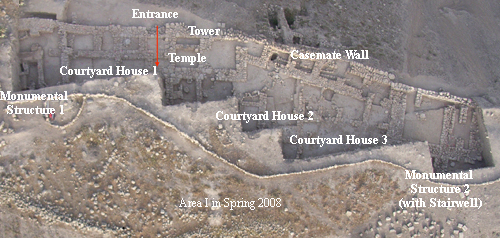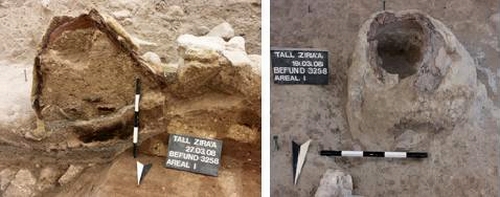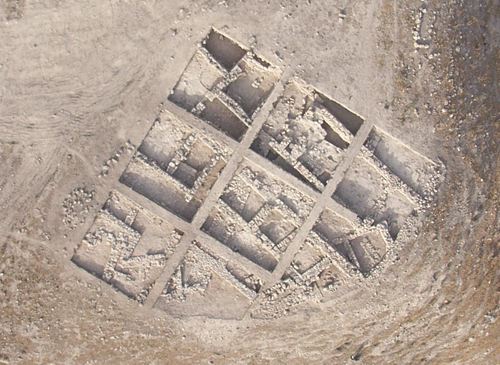
2008 - Campaign Spring
The 2008 Spring Campaign on Tall Zira'a ran from the 7th March to the 14th April. The team consisted of 21 regular members, 10 senior volunteers, 28 Thomas-Morus-Academy volunteers and 15 local workers. We are very grateful to all of them!This Spring we worked in Areas I and II - work will continue in Area III (Roman structure in the south of the tell) in Summer.
The main original objective of opening Area I in the western part of the tell was to understand the stratigraphy of the tell.

By the end of this year's Spring Campaign, Area I comprised 1075 m2 of excavated surface. The amount of information we have been able to gain form this area has been impressive: the successive layers have given us a valuable insight into the history of northern Transjordan from the late Bronze Age to the Islamic period. The history of the tell goes back much further than the late Bronze Age, of course (in fact, all the way to the 4th millennium BC), but for logistical reasons only 4.5 of the over 12 m of cultural layers can currently be accessed in this area.
In the southern part of Area I, a number of interesting finds were made, including a well-preserved taboon oven from the Iron Age I (in the image on the left, the taboon is dissected vertically, on the right is the find photo).
 Dissection of Tabun in AE 115 Tabun in trench AE 115
Dissection of Tabun in AE 115 Tabun in trench AE 115
Because 2009 has been set aside to publish our results to date, we wanted to excavate the entire surface of Area I to one level - the latest phase of the late Bronze Age (13th cent. BC). The monumental structures of the city-kingdom of this period that have been exposed are very impressive due to their excellent state of preservation and the precision of the architecture.
The late Bronze Age city was protected by a casemate wall. Towards the south of Area I we uncovered the remains of a massive tower in this wall which protected a pedestrian entrance that led to a footpath to the lower cities. We have also uncovered 3 courtyard houses, the eastern parts of all three of which remain to be excavated.
In the north and south of Area I we discovered monumental structures that will play an important role in our future excavation strategy. The first room of the northern structure that we excavated contained 23 cylinder seals. We now have a total of 30 cylinder seals from the area. This year we also found an impressive stairwell in the northern structure. Apart from the cylinder seals we also again found scarabs, a well-preserved kernos, a silver miniature vessel, many bronze tools (needles, awls, a chisel), an Egyptian/Egyptianising painted figurine, other figurine fragments and well-preserved daggers with studs that would once have held the handle. The large number of glass beads that have been found along with raw glass lenses and the appropriate industrial pottery vessels suggest that the tell may have been home to glass industry in the late Bronze Age. The newly-found cylinder seals are at differing levels of processing. For example, we have a completely unprocessed blank cylinder, which also suggests the presence of cylinder seal manufacturing on the tell. At the same time, we also have a great number of imports in the late Bronze Age from Cyprus, Mycenae and Phoenicia.

Area II is in the northeast of the tell. Because of its high position we expect this area to contain administrative and representative buildings. By the end of Spring 2008 we had opened more than 700 m². The impressive thing about the (Roman and Byzantine) buildings we have uncovered in this area is their generous use of space. We also found four almost entirely intact Byzantine amphorae in this area. In 2010 work will continue with an extension of the excavation area, after which, in subsequent years, we can expect to continue further downwards into the pre-Classical, prehistoric layers.
As always, this short summary comprises only the most important discoveries of the campaign. For further information please consult our publications in the ADAJ (Annual of the Department of Antiquities of Jordan) and in German-language journals. Please also consult our bibliography.
Last updated: 2008
|
CURRENT NOTE (2017) The results of the excavation campaigns from 2003 to 2011 are represented in detail in the final publication. |
 Close Window
Close Window print
print